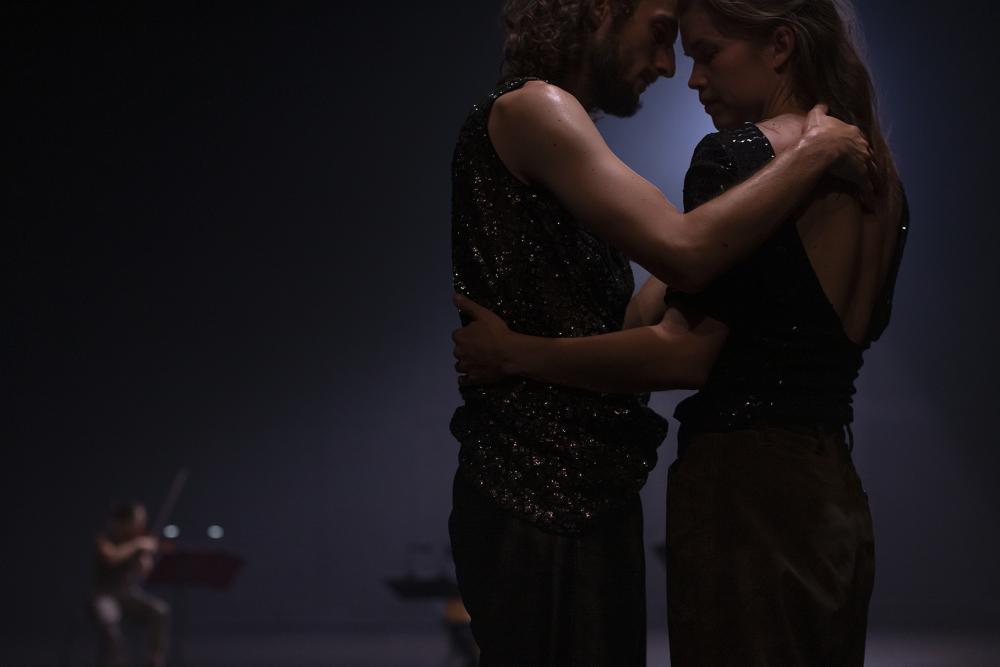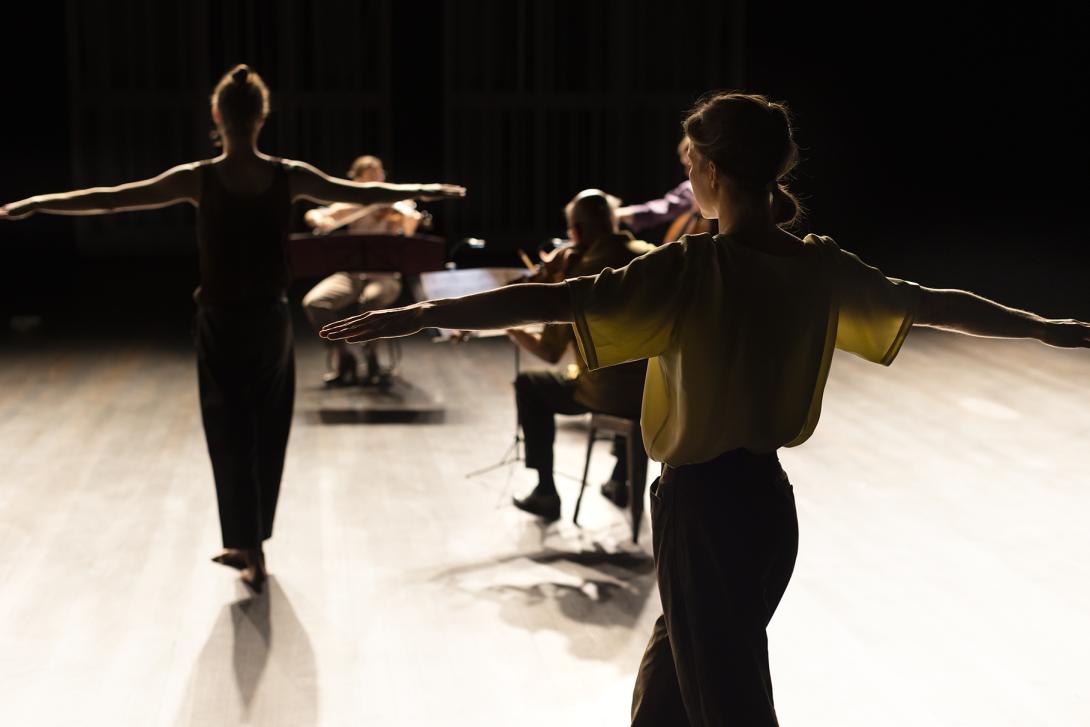| Mon | Tue | Wed | Thu | Fri | Sat | Sun |
|---|---|---|---|---|---|---|
|
1
|
2
|
3
|
4
|
5
|
6
|
7
|
|
8
|
9
|
10
|
11
|
12
|
13
|
14
|
|
15
|
16
|
17
|
18
|
19
|
20
|
21
|
|
22
|
23
|
24
|
25
|
26
|
27
|
28
|
|
29
|
30
|
31
|
|
|
|
|
Read more - Duet for two string trios
Here you find a short description of the performance and the credits.
Duet for two string trios guides us through a musical score that may seem bewildering at first, towards the rich rewards that lie behind
text by Julie De Meester (9/09/2021)
Applause greets the performers of Duet for two string trios as they take their positions on the stage of Concertgebouw Brugge on the night of the premiere: a reminder that we are dealing with a hybrid creature, as much a concert as a choreography, drawing an equally mixed audience. This performance by choreographer Claire Croizé was born out of an invitation by the Goeyvaerts String Trio: to add dance to two string trios by the contemporary classical composer Charles Wuorinen (1938-2020). In 1970 Wuorinen was the youngest composer ever to win the Pulitzer prize, two years after he composed his first String Trio. Fifty years later, he was so impressed with the Goeyvaerts String Trio that he dedicated his Second String Trio to them, and asked them to perform it on its premiere in the Guggenheim New York.
This half-century interval can be felt in the strong contrast between the two: the first piece is avant-garde, expressionist and energetic, consisting of different, continuously changing movements. Despite the challenges it presents, it seems in some ways made for dance, as a way for the musicians and audience both to understand better where the music is going. And indeed, it was initially performed in tandem with a choreography by Jean-Pierre Bonnefoux, of which, true to the ephemeral nature of that art form, no trace remains.
Musicians Pieter Stas (cello), Kris Mathynssens (viola) and Fedra Coppens (violin) looked for a choreographer who could repeat the exercise for both this piece and the Second String Trio, which in many ways could not be more different. Though both are based in the tradition of Schönberg’s twelve tone technique, the second trio is more restrained and, curiously, more classical than the first, with clear melodic lines and a lyrical undertone. Croizé’s choreography unites these divergent compositions, but also transposes their differences into the movement material. This finely crafted interplay of music and dance would not have been possible without the close collaboration between Croizé and the musicians, leading to a mutual understanding of each other’s processes and materials.
Croizé’s first vision, to have the movements coincide with Wuorinen’s technically demanding compositions, was not quite as intriguing as she had hoped. The dancers needed space and freedom to compose their own story alongside the music. This freedom she found in the use of text as a basis for movement and dramaturgy, a technique that she has made her own ever since 2016’s EVOL. And so, for the first trio, Emmi Väisänen and Jason Respilieux could draw from the verses of Cesare Pavese’s Dialogues with Leucó, more precisely the myth of Ixion, who is warned by the nymph Nefelis not to defy the laws of the gods.
With its themes of hubris and natural order, this is apt enough as a metaphor in times of a global pandemic. In a kind of twisted parable, the characters from Pavese’s text are embodied by the dancers both as fated lovers and forces of nature. But what does the audience see? Not a narrative per se, but not a traditional duet either, which often revolves around symmetry, touch, two bodies bearing each other’s weight. Here, the dynamic between the dancers follows the dynamic of the written dialogue, in a back-and-forth that borders on operatic, but never turns into theatre. In this way, a distance is created that mirrors the different musical voices, swerving in various directions, with Coppens’ violin often taking the lead over the other two instruments.
The ties between dance and music are shown in other, intricate ways throughout the piece: while it is true that the movement often takes its cue from the sound, Croizé has laced her choreography with subtle shifts and accents, so that at times, it seems rather like the music is driven by the dance. Hans Meijer’s light design, which at certain moments flickers and fluctuates along with the strokes of the musician’s bows, adds an unexpected layer to this dichotomy.
Just as the musicians throw their whole body into their performance of the score, the dancers translate the words of the text not simply through gestures, but with every part of their body. They spin around the trio, who are right in the eye of the storm, until even their dialogue is absorbed in an explosion of pure kinetic energy.
And then, the aftermath. Croizé leaves a quiet space in between the two string trios for both audience and performers to take a deep breath. Taking turns, the dancers wander idly through plumes of smoke. The reality of the stage collides with our own as a technician walks past to make subtle changes to the set-up: an act that, in breaking the spell of the performance, makes everything else feel briefly surreal.
It is the perfect preamble for Wuorinen’s Second String Trio, which is set in a kind of dreamscape, with hazy, lustrous lighting evoking a moonlit night. Costume designer Anne-Catherine Kunz, always a master of detail, has orchestrated small changes in the costumes – a collar unbuttoned, hair let down, a shimmering velvet top in place of an earth-toned one – creating the feeling that hours, rather than minutes, have gone by unnoticed.
To inspire the movements, Croizé returns to Rainer Maria Rilke, one of her muses for pieces like EVOL (2016), HERO (2018) and Flowers, we are (2019). She gave the dancers texts that match the quiet lyricism of the Second String Trio, creating an intimate, introspective mood. The musician’s paths stay closer together, and the dancers, too, perform more unisono. It is a different way to confront the same questions, just as the dancers still reach for the sky, but now through soaring lifts rather than frantic jumps.
If the first part of Duet for two string trios evokes urgency and tension, this second part could be the shoulder on which our troubled world gently rests its head. Much like the thread that showed Theseus the way through the labyrinth in yet another myth, Duet for two string trios guides us through a musical score that may seem bewildering at first, towards the rich rewards that lie behind.

